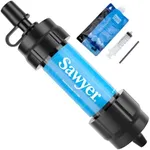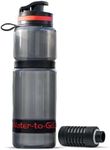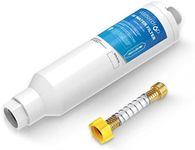Buying Guide for the Best Water Filtration Bottle For Foreign Travel
Choosing a water filtration bottle for foreign travel is a smart way to stay healthy and hydrated when you’re unsure about the safety of local water sources. The right bottle can protect you from bacteria, viruses, and other contaminants, making it easier to drink confidently wherever you go. When picking a water filtration bottle, it’s important to understand the key features that affect how well it works, how easy it is to use, and how suitable it is for your travel style.Filtration TypeFiltration type refers to the method the bottle uses to clean water, such as activated carbon, hollow fiber membranes, or UV light. This is important because different types remove different contaminants. For example, carbon filters are good for improving taste and removing chemicals, while hollow fiber filters can block bacteria and protozoa. UV filters can neutralize viruses. If you’re traveling to places with questionable water quality, especially in developing countries, look for bottles that protect against bacteria, protozoa, and viruses. If you’re mostly concerned about taste or minor impurities, a simpler filter may be enough.
Filter Pore SizeFilter pore size is measured in microns and tells you how small the particles are that the filter can block. Smaller pore sizes (like 0.1 or 0.2 microns) can remove bacteria and protozoa, while larger pores may only filter out dirt and debris. For foreign travel, especially in areas with poor sanitation, choose a bottle with a pore size of 0.2 microns or smaller to ensure you’re protected from most harmful microorganisms.
Virus ProtectionNot all filters remove viruses, which are much smaller than bacteria. If you’re traveling to regions where waterborne viruses are a risk, look for bottles that specifically mention virus protection, either through advanced filtration or UV purification. If you’re traveling to places with generally safe water, this may be less critical, but for developing countries or remote areas, virus protection is a key feature.
Filter LifespanFilter lifespan tells you how much water you can purify before needing to replace the filter. This is important for planning your trip and avoiding running out of clean water. Lifespans can range from a few hundred to several thousand liters. If you’re going on a long trip or won’t have access to replacement filters, choose a bottle with a longer lifespan. For short trips, a lower lifespan may be sufficient.
Ease of UseEase of use covers how simple it is to fill, drink from, and clean the bottle. Some bottles require squeezing, pumping, or waiting for gravity to work, while others let you drink directly. If you want quick and convenient access to water, look for bottles that allow you to drink straight away. If you don’t mind waiting or doing a bit more work, other types may be fine. Consider your patience and the situations you’ll be in when choosing.
Bottle CapacityBottle capacity is the amount of water the bottle can hold, usually measured in liters or ounces. A larger bottle means you can carry more water, which is useful if you’ll be away from water sources for a while. However, bigger bottles are heavier and bulkier. If you’ll have frequent access to water, a smaller, lighter bottle may be more comfortable to carry. Think about your daily activities and how often you’ll be able to refill.
Weight and PortabilityWeight and portability refer to how easy the bottle is to carry around. Lightweight bottles are better for travel, especially if you’re moving around a lot or trying to pack light. Some bottles are collapsible or have features that make them easier to pack. If you’re backpacking or traveling with limited luggage space, prioritize a bottle that’s light and easy to store.
Material and DurabilityThe material of the bottle affects how tough it is and how long it will last. Common materials include plastic, stainless steel, and silicone. Durable bottles are important for travel, as they’ll be exposed to bumps and drops. If you’re going to rugged areas or expect rough handling, choose a bottle made from sturdy materials. If you’re mostly in urban settings, a lighter, less rugged bottle may be fine.

















